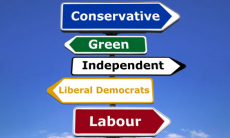
The General Election – which happens every 5 years – is now very closely looming, and campaigning is entering its final stages. But with the election taking over the media for these few weeks, it can be difficult to see what each party actually stands for. In the very recent past (basically, the last election) only 3 parties had any real chance of getting English seats in Parliament. These three parties were Labour, the Conservatives and the Liberal Democrats. This upcoming election is likely to be very different, as fringe parties like UKIP and the Green Party have a greater chance of winning seats in English constituencies. I say English constituencies because it’s often the case parties like the Scottish National Party, Plaid Cymru and the various Irish parties get seats in Scotland, Wales and Northern Ireland, respectively.
So let’s start by looking at what the main parties are all about. The Conservatives (who lead the current government) are a centre-right wing party. This means that they believe in basic human rights, but their economic theory is different. The Conservative Party would prefer that the market (trade, finance etc) had a bigger role in the business cycle. Dislike of the European Union is stronger here than it is in the other 2 mainstream parties.
The Liberal Democrats are pretty much dead centre, and lie somewhere between Labour and the Conservatives. In truth, the parties are all pretty similar, and the difference is in the detail. The Liberal Democrats have a similar economic belief to the Conservatives, that the market should have little interference from government. However, their social policy is a little bigger, and they believe in actually ensuring equality of opportunity. This means everyone has the same chances in life, regardless of class, gender, race, sexuality etc.
Labour are left of centre, but between 1997-2007 Britain was under a “new Labour” government, which became similar to the Liberal Democrats or even left-wing Conservatives. Now, Ed Miliband is trying to change Labour’s policies to include more government involvement with the market, including a safety net for those who need it. They believe in “equality of outcome”, which tries to combat institutional discrimination by trying to get women, ethnic minorities etc. into higher positions.
UKIP is a relatively new party, and its popularity has grown very quickly in the past couple of years. UKIP’s main platform is to get Britain out of the European Union, and because of this they have often been criticised as being a party that hasn’t got any good policies on other topics, like the NHS.
The Green Party currently have one seat in Parliament – Brighton Pavilion. They are a party that believes the government needs to do more to combat the environmental problem facing the world, and they have other left-wing politics too. It’s very popular with students.
There are also other parties in Northern Ireland, Wales and Scotland. The most well-known of these is the SNP, the ones that pushed for last year’s vote on whether Scotland should be an independent country or not. In Wales, there is Plaid Cymru, who support giving more powers to the Welsh assembly. There are lots of different parties in Northern Ireland, mainly based on their views of the British and Irish troubles.
Hopefully that makes things a little clearer for you! Though you probably can’t vote yet, it never hurts to impress your friends and teachers with how read-up you are on national politics.
Image from: http://history-geography.blogspot.co.uk/2014/03/policy-comparison-between-political.html

0 Comment:
Be the first one to comment on this article.